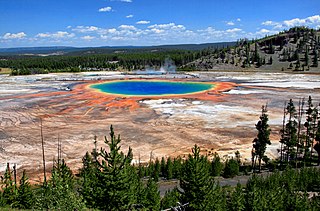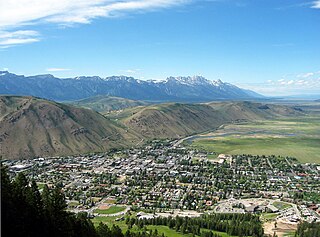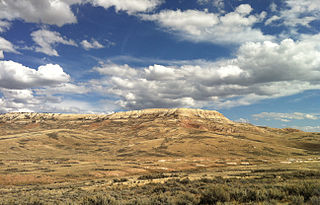Top 10 Places to Visit in Wyoming

Photograph by Brocken Inaglory, via Wikimedia Commons
#1 Yellowstone National Park
The first national park of U.S., Yellowstone National Park is known for its wildlife. The park is home to hot springs and geysers. Yellowstone National Park covers canyons, rivers, and mountain ranges. Yellowstone Lake is one of the largest high-elevation lakes. Half of the world's geysers and hydrothermal features are in Yellowstone, fueled by ongoing volcanism. During the winter, visitors can experience snow-covered landscapes.
Photograph by Daniel Mayer, via Wikimedia Commons
#2 Grand Teton National Park
Located in northwestern Wyoming, Grand Teton National Park is known for 40 mile long Teton Range. The park is located just 10 miles south of Yellowstone National Park, which makes it more popular. The national park includes major peaks as well as numerous lakes including 15 mile long Jackson Lake. Colter Bay located in the northern part of the park offers many water recreation opportunities. Jenny Lake, String Lake, and Leigh Lakes offers various recreation and access to multiple trails. Recreation activities include hiking, mountaineering, camping, boating, float the Snake River, wildlife viewing, and fishing. Winter activities include snowshoeing and cross-country skiing.
Photograph by Charles Willgren, via Wikimedia Commons
#3 Hot Springs State Park
Located along the Big Horn River in Thermopolis, Hot Springs State Park is known for its hot springs which flow from mineral hot springs at a constant temperature of 128 degrees Fahrenheit. The park has a free bath house where temperature is maintained at 104 degrees for therapeutic bathing. The park is also known for herd of bison. Park activities include hiking, picnicking, boating, and fishing. The Swinging Bridge is a suspension foot bridge across the Bighorn River that offers view of the river and the park. Legend Rock Petroglyph Site is located 20 miles northwest of the park features hundreds of individual petroglyphs spread across the face of the rock.
Photograph by Mlewis2005, via Wikimedia Commons
#4 Jackson
Located in Jackson Hole valley, Jackson is a popular tourist destination. The town attracts visitors due to near by ski resorts: Jackson Hole Mountain, Snow King Mountain, and Grand Targhee. Grand Teton National Park and Yellowstone National Park visitors also visit the town. Other attractions include National Elk Refuge and National Museum of Wildlife Art. Jackson is also known for Grand Teton Music Festival that last for seven week in summer. Over 200 classical musicians from more than 90 different orchestras and 40 institutions of higher learning participate in the classical music festival.
Photograph by G. Thomas, via Wikimedia Commons
#5 Bridger-Teton National Forest
Located in Western Wyoming, Bridger-Teton National Forest is one of the largest 3.4 million acres forest. It includes large part of the Greater Yellowstone and stretches from Yellowstone National Park to the Wind River Range. Known for it's wilderness, the forest offers many recreation activities. The forest is home to the tallest mountain in Wyoming including the highest Gannett Peak. It includes over 2,000 miles of hiking trails with access to Yellowstone National Park. Recreation activities include hiking, mountain biking, camping, and fishing.
Photograph by Bradlyons, via Wikimedia Commons
#6 Cheyenne
The capital city Cheyenne is home to several historic district. Wyoming State Capitol located north of downtown is prime attraction for visitors. The copper dome of the capitol with 24-carat gold leaf stands out and visible from almost all roads. Downtown Cheyenne is a historic district with many masonry historic buildings: Richardsonian Romanesque, Dinneen Building, and Masonic Temple. Top places to visit include State Capitol Building, Cheyenne Depot Museum, Wyoming State Museum, Cheyenne Botanic Gardens, and Wyoming Historic Governors' Mansion.
Photograph by Jonathunder, via Wikimedia Commons
#7 Devils Tower National Monument
Located in northeastern Wyoming, Devils Tower is known its unique geologic feature. The 1,267 feet tower can be seen from the park entrance to the visitor center. The Tower Trail and other hiking trails offer more views of the Tower. It was considered sacred by Northern Plains Indians and indigenous people. The 1,347 acres Devils Tower National Monument offers hiking trails, rock climbing, campground, and picnic areas.
Photograph by Paul Hermans, via Wikimedia Commons
#8 Buffalo Bill Center of the West
Buffalo Bill Center of the West formerly known as the Buffalo Bill Historical Center is located outside Yellowstone National Park's East Gate. The Center named after founder William F. Buffalo Bill Cody includes five museums: Draper Natural History Museum, Buffalo Bill Museum, Plains Indian Museum, Whitney Western Art Museum, and Cody Firearms Museum. Buffalo Bill Museum is a western history museum dedicated to life of William F. Cody. Plains Indians Museum features the stories of Plains Indian cultures, traditions, trials, and triumphs. Whitney Western Art Museum features paintings and sculptures of the American West. Draper Natural History Museum features interactive exhibits of the Greater Yellowstone region. Cody Firearms Museum features over 10,000 artifacts of American firearms.
Photograph by National Park Service, via Wikimedia Commons
#9 Bighorn Canyon National Recreation Area
Bighorn Canyon National Recreation Area is located on the border of Wyoming and Montana. The 120,000 acres park features diverse ecosystems and wildlife to explore. Bighorn Lake reservoir behind Yellowtail Dam offers many recreation activities including boating, kayaking, and canoeing. Bighorn Canyon features 17 miles of hiking trails. The south Lovell, WY district of Bighorn Canyon has 12 trails. Other activities of Bighorn Canyon National Recreation Area include hiking, camping, fishing.
Photograph by Leaflet, via Wikimedia Commons